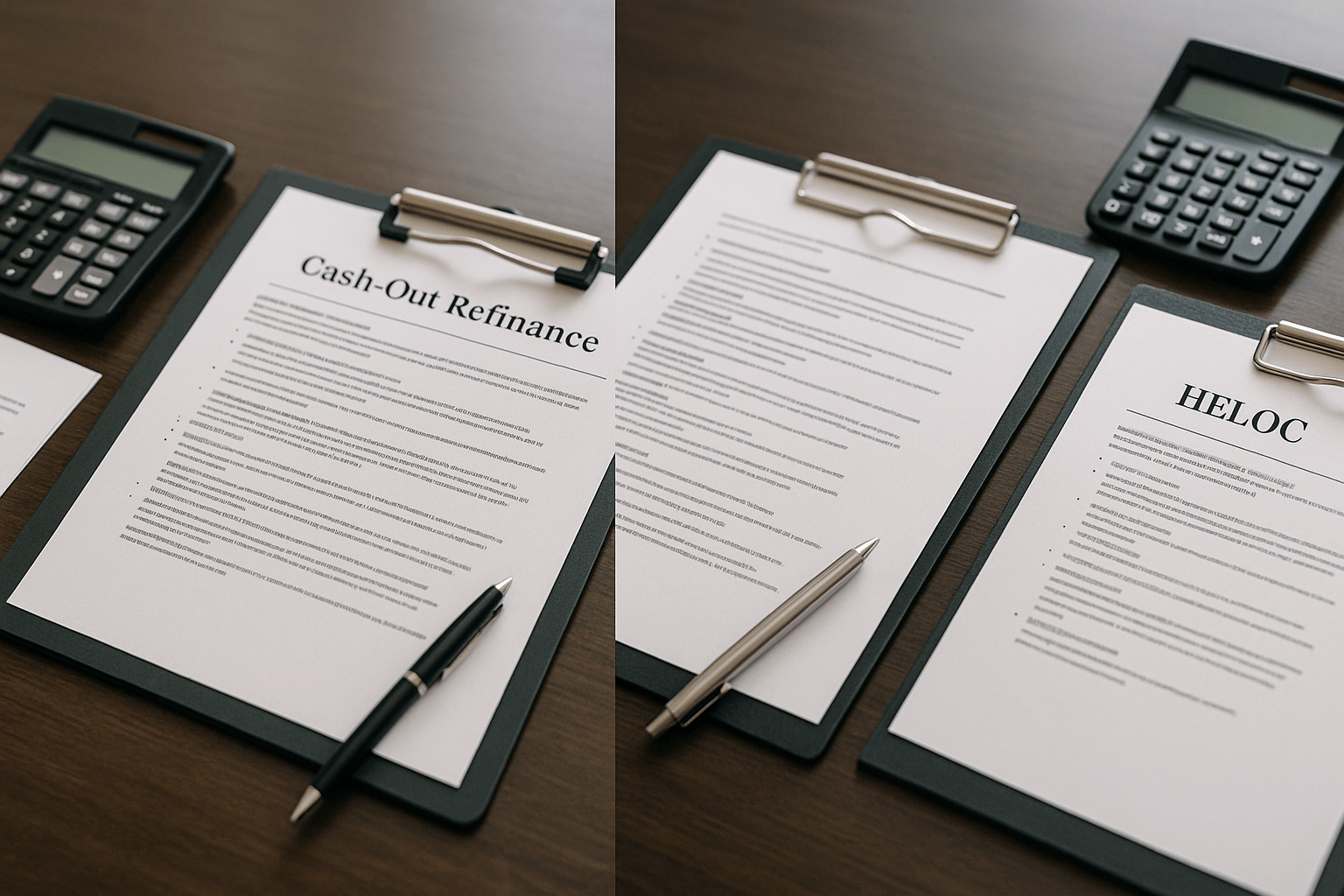Cash Out Refinance vs HELOC: Which Equity Access Strategy Is Right for You?
Cash Out Refinance vs HELOC: Which Equity Access Strategy Is Right for You?

Understanding Your Home Equity Access Options
You’ve built equity in your home—congratulations. But now you’re facing a choice that feels more complicated than it should be: cash-out refinance or HELOC? Both let you tap into that equity, but they work in fundamentally different ways. Choose wrong, and you could pay thousands more in interest or lock yourself into the wrong financial structure for your needs.
In this guide, you’ll discover:
- How cash-out refinancing and HELOCs actually work (per CFPB mortgage guidelines)
- When each option makes financial sense for your situation
- The hidden costs and benefits most homeowners miss (according to Freddie Mac research)
- Real scenarios showing which tool fits which goal
- A decision framework to choose confidently
Questions about your specific situation? Schedule a call to speak with a loan advisor who can run your numbers.
What Is a Cash-Out Refinance?
A cash-out refinance replaces your existing mortgage with a new, larger loan. You receive the difference between the two loan amounts as cash at closing.
How it works: If your home is worth a substantial amount and you owe less than that in mortgage debt, you can refinance for a higher amount. The lender pays off your old mortgage and hands you the difference in cash.
Rate structure: Fixed rate mortgages are typical for cash-out refinances. Your monthly payment includes both principal and interest, fully amortized over the loan term. Rates tend to run slightly higher than rate-and-term refinances—typically around half a percentage point more.
Loan amounts: Most lenders allow you to borrow up to a certain percentage of your home’s value, usually leaving you with significant equity remaining as a cushion.
Closing costs: Expect to pay closing costs similar to your original mortgage—typically a percentage of the new loan amount. These include appraisal fees, title insurance, origination charges, and other standard mortgage expenses.
Timeline: The refinance process typically takes one to one and a half months from application to closing. You’ll go through underwriting, appraisal, and all the steps of a full mortgage origination.
Best for: Large, one-time needs where you want the certainty of a fixed rate and fixed payment. Think major home renovations, debt consolidation, or investment property purchases.
Use the cash-out refinance calculator to see how a cash-out refinance would impact your monthly payment and total loan amount.
What Is a HELOC?
A HELOC (Home Equity Line of Credit) is a revolving credit line secured by your home equity. Think of it like a credit card backed by your house.
How it works: You’re approved for a maximum credit line based on your available equity. During the draw period, you can borrow, repay, and borrow again up to your limit. You only pay interest on what you actually use.
Rate structure: Variable rates are standard for HELOCs, typically tied to the prime rate plus a margin. As the prime rate moves, so does your rate. Some lenders now offer fixed-rate options or the ability to lock portions of your balance.
Draw period: Usually lasts five to ten years. During this time, you make interest-only payments on whatever amount you’ve borrowed. You can pay down principal if you want, but it’s not required.
Repayment period: After the draw period ends, you enter repayment mode—typically ten to twenty years. Now you pay both principal and interest on your outstanding balance.
Access: Pull funds as needed using checks, a debit card, or online transfers. It’s incredibly flexible—borrow a little here, a little there, whatever your project requires.
Closing costs: Much lower than a cash-out refinance. Many lenders charge minimal fees, sometimes waiving closing costs entirely if you keep the line open for a certain period.
Best for: Ongoing projects with uncertain costs or timing, emergency fund backup, multiple smaller expenses over time, or situations where you want flexibility.
Check how a HELOC would work with your home’s equity using our calculator.

Cash-Out Refinance vs HELOC: Side-by-Side Comparison
Interest rates:
- Cash-out refinance: Fixed rate, typically half a percentage point higher than a rate-and-term refinance
- HELOC: Variable rate, often starts lower but can increase with market changes
Payment structure:
- Cash-out refinance: Fixed monthly payment combining principal and interest, predictable for budgeting
- HELOC: Interest-only during draw period, then principal plus interest during repayment—can create payment shock
Access to funds:
- Cash-out refinance: Lump sum at closing, one-time access
- HELOC: Draw as needed up to your credit limit, revolving access during draw period
Flexibility:
- Cash-out refinance: Locked in—you’d need another refinance to access more equity
- HELOC: Revolving credit—pay down and reuse during draw period
Closing costs:
- Cash-out refinance: Several thousand in costs depending on loan amount
- HELOC: Minimal costs, often just a few hundred or waived entirely
Tax deductibility:
- Both: Potentially deductible if funds used for substantial home improvements (per IRS guidelines)
- Neither: Not deductible for personal expenses like debt consolidation or vacations
- Consult a tax advisor for your specific situation
Credit requirements:
- Cash-out refinance: Typically need a credit score in the mid-six hundreds or higher for best rates
- HELOC: Usually requires a slightly higher credit score threshold
Time to close:
- Cash-out refinance: One to one and a half months typical
- HELOC: Two to four weeks average
When to Choose a Cash-Out Refinance
Scenario 1: Large One-Time Need
You know exactly how much you need, and you need it all at once. A kitchen remodel with a fixed bid. College tuition for the semester. An investment property down payment.
Example: Your contractor quotes a fixed amount for a complete kitchen renovation. You want the funds immediately to start work. A cash-out refinance gets you the full amount at closing so you can pay the contractor and begin the project without delay.
Link to debt consolidation calculator to see potential savings if using funds to pay off high-interest debt.
Scenario 2: Debt Consolidation
You’re juggling multiple high-interest debts—credit cards, personal loans, maybe an auto loan or two. A cash-out refinance lets you consolidate everything into your mortgage at a much lower rate.
Example: You have credit card debt at high interest rates. A cash-out refinance at a much lower mortgage rate could save you hundreds monthly. The math is straightforward: pay off high-interest debt with low-interest mortgage debt.
Real example from a cash-out refinance case study: A physical therapist consolidated debt and lowered total monthly payments significantly.
Scenario 3: Rate Improvement Opportunity
Your current mortgage rate sits above current market rates. A cash-out refinance lets you lower your existing rate AND pull cash out simultaneously—two benefits in one transaction.
Example: Your mortgage rate is noticeably higher than today’s rates. Market rates have dropped enough that even with a slightly higher cash-out rate versus a straight refinance, you’re still improving your existing rate while accessing equity.
Scenario 4: Predictable Fixed Payment Preference
You value certainty. Variable rates make you uncomfortable. You want to know exactly what your payment will be every month for the long term.
Example: You’re a planner who budgets carefully. The thought of a variable-rate HELOC that could increase your payment unexpectedly creates anxiety. A fixed-rate cash-out refinance gives you peace of mind with a locked payment.
Scenario 5: Investment Property Purchase
You’re using equity strategically to buy a rental property or investment real estate. You need a lump sum for a down payment on a DSCR loan or another investment property.
Example: You’ve found an investment property that will generate positive cash flow. A cash-out refinance provides the down payment needed. Use the rental property calculator to analyze the investment potential.

When to Choose a HELOC
Scenario 1: Phased Renovation Project
Your home improvement plan spans multiple years or phases. You don’t need all the money upfront, and you don’t want to pay interest on funds you haven’t used yet.
Example: Year one you’re doing the kitchen, year two the bathrooms, year three the basement. With a HELOC, you draw funds as each phase begins and only pay interest on what you’ve actually borrowed. A home improvement loan might also work, but a HELOC offers more flexibility if timelines shift.
Use the HELOC calculator to see how drawing funds incrementally affects your payments.
Scenario 2: Emergency Fund Backup
You want access to equity for emergencies without actually borrowing unless you need to. A HELOC sits there available—costing you nothing if unused—ready when life throws a curveball.
Example: You maintain an emergency fund in savings, but having a HELOC as additional backup provides extra peace of mind. Medical emergency, job loss, major home repair—you have access to funds without depleting your savings first.
Scenario 3: Real Estate Investment Opportunities
You’re actively looking for investment deals. When the right property appears, you need to act fast. A HELOC lets you deploy capital quickly.
Example: You’re pursuing fix-and-flip opportunities. One deal might need a certain amount, another deal a different amount. A HELOC gives you the flexibility to fund multiple smaller investments as opportunities arise.
Scenario 4: Business Funding Needs
Your business has variable capital needs. Rather than expensive business credit lines, you use a HELOC backed by home equity at a lower rate.
Example: You’re self-employed with fluctuating business expenses. A HELOC provides working capital at rates lower than business credit cards or merchant cash advances. Repay when cash flow is strong, draw again when needed.
Scenario 5: Unknown Timeline or Amount
You know you’ll need money for something, but you’re not sure exactly how much or when. Maybe adult children might need help. Maybe a business opportunity will appear. Maybe home repairs will surface.
Example: Your home is older, and you know systems might need replacement—roof, HVAC, water heater—but you don’t know which or when. A HELOC provides ready access without committing to a specific amount upfront.
Can You Use Both? The Advanced Strategy
Some homeowners don’t choose—they use both strategically.
The blended approach: Cash-out refinance for known, immediate needs. HELOC for future flexibility.
Example scenario:
- Cash out a substantial amount to consolidate all high-interest debt
- Open a HELOC for future opportunities or emergencies
- Result: Debt eliminated, flexibility maintained, financial breathing room created
Timing considerations:
Simultaneous: Some lenders allow both in the same transaction. You refinance your first mortgage and open a HELOC simultaneously, subject to combined loan-to-value limits.
Separate: More commonly, you complete the cash-out refinance first, then add a HELOC three to six months later once the refinance has seasoned.
Combined loan-to-value limits: Lenders typically cap combined borrowing at a certain percentage of home value. If your cash-out refinance uses a significant portion, you might be able to add a HELOC for the remaining available equity.
Strategic layering over time:
An alternative to mortgage recast might be this strategic approach:
- Year one: Cash-out refinance for major renovation
- Year three: Add HELOC for ongoing flexibility
- Year six: Potentially refinance again to consolidate if beneficial
This rhythm—when done with clear intention and solid math—becomes a system of empowerment rather than just financial shuffling.

The Interest-Only Trap with HELOCs
HELOCs can feel deceptively affordable during the draw period. Then repayment period hits, and homeowners experience payment shock.
Understanding the structure:
During the draw period, you only pay interest. It feels manageable, even comfortable. But when the draw period ends, you suddenly owe principal plus interest on your outstanding balance. Your payment can nearly double.
Example: You borrow a substantial amount on a HELOC at a certain interest rate.
- Draw period payment: Interest only, feels affordable
- Repayment period payment: Principal plus interest, significantly higher
- Payment nearly doubles when repayment begins!
How to avoid problems:
Make principal payments during the draw period even though they’re not required. Treat your HELOC like a regular loan, not a minimum-payment trap.
Calculate what your future payment will be before drawing large amounts. Budget for the repayment period payment from day one, not just the draw period payment.
Pay off the balance before the repayment period starts if possible, or be prepared for the payment increase.
Consider refinancing to a fixed-rate loan before the repayment period begins if you’ll carry a significant balance.
Use the HELOC calculator to see exactly how your payment changes when repayment starts. Don’t get caught by surprise.
Tax Considerations for Both Options
Deductibility rules:
If you use the funds for buying, building, or substantially improving your home, the interest may be tax-deductible (per IRS mortgage interest deduction guidelines). But if you use the money for personal expenses—debt consolidation, vacation, car purchase—the interest typically isn’t deductible.
What counts as substantial improvement:
Adding a room, finishing a basement, major kitchen or bathroom renovation, new roof, HVAC replacement. These improvements add value or prolong the home’s useful life.
What doesn’t count:
Paying off credit cards, funding a vacation, buying a car, even if the loan is secured by your home.
Documentation requirements:
Keep receipts for all home improvements. Track how you spent the borrowed funds. If audited, you’ll need to prove the money went toward substantial home improvements to claim the deduction.
Tax laws change, and individual situations vary. Consult with a qualified tax advisor before making financial decisions based on potential deductions.
How to Decide: Your Decision Framework
Question 1: How much do I need?
- Under a moderate amount → Lean toward HELOC
- Over a substantial amount → Lean toward cash-out refinance
- In between → Calculate the costs of each option
Question 2: When do I need it?
- All at once for a specific purpose → Cash-out refinance
- Over time as projects progress → HELOC
- Unknown timeline → HELOC
Question 3: How is my current mortgage rate?
- Higher than current market rates → Cash-out refinance (improve your rate while accessing equity)
- Already at a favorable rate → HELOC (don’t give up your good rate)
Question 4: How do I feel about variable rates?
- Comfortable with rate fluctuation → HELOC is acceptable
- Want payment certainty → Cash-out refinance
Question 5: What are the closing costs, and what’s my break-even?
- Cash-out refinance: Calculate break-even by dividing closing costs by monthly benefit
- HELOC: Usually minimal costs make break-even less of a concern
Question 6: How long am I staying in this home?
- Short term (one to three years) → HELOC (lower upfront costs)
- Long term (five-plus years) → Either option works
- Unsure → HELOC (more flexible if plans change)
Run the numbers on both options. Compare actual costs, not just interest rates. Consider your specific goals and timeline. The “best” option is the one that fits your situation—not the one with the lowest advertised rate.

Next Steps: Choosing Your Equity Access Strategy
You’ve now got the full picture of cash-out refinancing versus HELOCs. The decision comes down to your specific situation: how much you need, when you need it, your comfort with variable rates, and how long you’re staying in your home.
Ready to explore your options?
Talk to a loan advisor who can run your specific numbers and show you exactly what each option would cost and save. Compare offers from multiple lenders to ensure you’re getting competitive terms.
Consider whether a blended approach—using both tools strategically—might serve your goals better than choosing just one.
Schedule a call with a Stairway Mortgage advisor, or get pre-approved to see your actual equity access options and rates.
Run your numbers:
Frequently Asked Questions
Can I get both a cash-out refinance and HELOC at the same time?
Yes, some lenders allow both in one transaction, subject to combined loan-to-value limits. More commonly, you’d complete the cash-out refinance first, then add a HELOC three to six months later once the refinance has seasoned.
Which option has better tax benefits?
Both can offer similar tax treatment if used for substantial home improvements. The tax benefit depends on how you use the funds, not which product you choose. Neither option provides tax benefits for personal expenses like debt consolidation or vacations. Always consult a tax advisor for your specific situation.
If interest rates are rising, which option is better?
A cash-out refinance locks in a fixed rate, protecting you from future increases. HELOC rates will rise along with market rates. In a rising-rate environment, the certainty of a fixed-rate cash-out refinance becomes more attractive.
Can I refinance my HELOC into my mortgage later?
Yes, you can refinance to pay off both your first mortgage and HELOC, consolidating them into a single loan. This is common when the HELOC draw period is ending and you want to avoid the payment increase that comes with the repayment period.
How much equity do I need for each option?
Both typically require that you maintain at least a certain percentage equity in your home after borrowing. Cash-out refinances usually allow borrowing up to a specific loan-to-value ratio, while HELOCs may allow slightly higher combined loan-to-value when paired with your first mortgage.
Also Helpful for Homeowners
- Debt Consolidation Refinance: When using equity to pay off high-interest debt makes sense
- When to Refinance Mortgage: Strategic timing for your equity access decisions
- Home Improvements Best ROI: Which renovations are worth financing with equity
What’s Next in Your Journey?
- Explore specific cash-out refinance programs and rates
- Calculate your available equity with our equity calculators
- Review case studies of homeowners who used each strategy successfully
Explore Your Complete Options
Need a Pre-Approval Letter—Fast?
Buying a home soon? Complete our short form and we’ll connect you with the best loan options for your target property and financial situation—fast.
- Only 2 minutes to complete
- Quick turnaround on pre-approval
- No credit score impact
Got a Few Questions First?
Let’s talk it through. Book a call and one of our friendly advisors will be in touch to guide you personally.
Schedule a CallNot Sure About Your Next Step?
Skip the guesswork. Take our quick Discovery Quiz to uncover your top financial priorities, so we can guide you toward the wealth-building strategies that fit your life.
- Takes just 5 minutes
- Tailored results based on your answers
- No credit check required
Related Posts
Subscribe to our newsletter
Get new posts and insights in your inbox.






